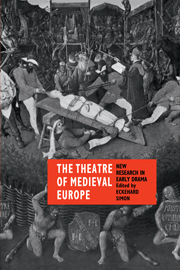Book contents
- Frontmatter
- Contents
- List of contributors
- Preface
- Note on the bibliography and system of references
- List of abbreviations for journals and series
- 1 Introduction: trends in international drama research
- PART I LATIN DRAMA
- PART II ENGLISH DRAMA
- 4 Modern editions of medieval English plays
- 5 The English mystery cycles
- 6 Castles in the air: the morality plays
- 7 ‘All the world was a stage’: Records of Early English Drama
- 8 The staging of medieval English plays
- PART III CONTINENTAL DRAMA
- Bibliography
- Author index to the bibliography
- General index
6 - Castles in the air: the morality plays
Published online by Cambridge University Press: 29 March 2011
- Frontmatter
- Contents
- List of contributors
- Preface
- Note on the bibliography and system of references
- List of abbreviations for journals and series
- 1 Introduction: trends in international drama research
- PART I LATIN DRAMA
- PART II ENGLISH DRAMA
- 4 Modern editions of medieval English plays
- 5 The English mystery cycles
- 6 Castles in the air: the morality plays
- 7 ‘All the world was a stage’: Records of Early English Drama
- 8 The staging of medieval English plays
- PART III CONTINENTAL DRAMA
- Bibliography
- Author index to the bibliography
- General index
Summary
In order to discuss trends and new developments in the study of morality drama during the last twenty-five years or so, we need first to say a word as to what scholarship had achieved by 1965. Robert Potter has aptly summarised the earlier history of attitudes toward the morality in his chapter on ‘Rediscovering the Evidence: 1660–1914’ in his book, The English Morality Play (1975), and I need not retrace his steps in detail. The story is largely one of neo-classical preconceptions against a drama so distinctively non-classical in form and substance, of haphazard collection of materials by antiquarians (Robert Dodsley's Old English Plays, 1744, being compiled chiefly from the Harleian collection that Dodsley had recently acquired and thus happened to have at hand), of Romantic apathy towards an anonymous drama so theologically plodding and lacking in individuality of self-expression and of Protestant Victorian distaste for a drama that was so egregiously Catholic and so irredeemably bawdy or scatological. Important discoveries were made, to be sure, including the recovery of Everyman and the Macro manuscript, but virtually in despite of scholarly antipathy towards the material under consideration. Morality plays were curiosities to be catalogued and collected like specimens (as suggested by John Matthews Manly's title, Specimens of the Pre-Shaksperean Drama, 1897). The plays' main interest was in their very distant foreshadowing of the greatness to come in Elizabethan drama, a greatness that indeed was attributed chiefly to classical models rather than to native ones.
- Type
- Chapter
- Information
- The Theatre of Medieval EuropeNew Research in Early Drama, pp. 97 - 116Publisher: Cambridge University PressPrint publication year: 1991



